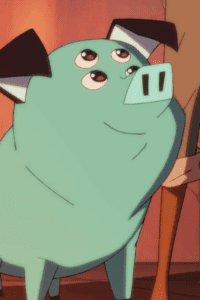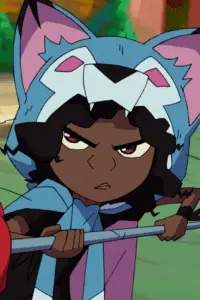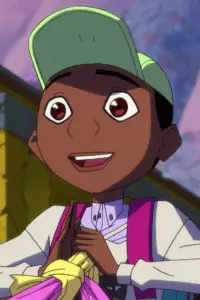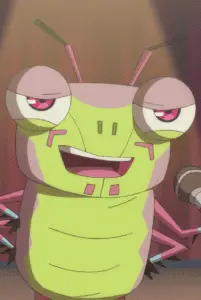Dreamworks’ Kipo and the Age of Wonderbeasts is a masterpiece made for viewers of all ages. Found family, ethical dilemmas, right versus wrong, the power of compassion, second chances, human impact on the environment and animal kingdom, and more are explored masterfully. Kipo is hilarious, emotional, scary, dramatic, and a true masterclass in writing a show primarily for children but that their parents and other viewers of all ages can enjoy. With a truly inclusive cast, writer’s room, and crew, it’s clear everyone involved has really thought through what it means to write about these issues in the last two years! As another one of our writers said, Kipo is an incredible feat of artistry.
An adaptation of creator Radford Sechrist’s eponymous comic, developed by Bill Wolkoff, beautifully animated by Korean Studio Mir, with art direction by Angela Sung, and set to the best soundtrack by Daniel Rojas, the show follows Kipo, a thirteen-year-old human-mute girl who finds herself up on the surface after living underground in a burrow her whole life circa 2200.
Attempting to make her way home, she meets a mutant pig she names Mandu, Wolf a surface survivor wearing a wolf pelt, Benson, another surface survivor who loves music and his best friend Dave, a mutant insect that constantly molts through the aging process.
Kipo and the audience learn that above ground there are mutated animals (mutes for short) ranging in size with “mega” mutes being the largest. All but the megas appear to talk. A number of animal groups appear throughout the first two seasons with their own personalities and alliances. From the Mod Frogs who wear suits to the Newton Wolves who are incredibly “civilized” and smart.
The mutes are a really great example of the beauty in the show. Post-apocalyptic stories are usually so dark and grungy. Kipo is the complete opposite with saturated scenes and the full use of the color wheel, Studio Mir (which animated it all on paper!) highlights just how visually tasty shows can and should be.
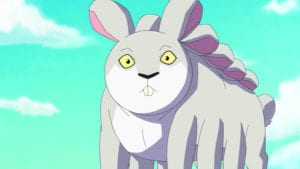
Unsurprisingly, Wolf and Benson explain to Kipo that humans and mutes do not get along but the show wouldn’t work without Kipo’s unrelenting enthusiasm and kindness so she ends up befriending many of the animals we meet along her journey and even teaches our first “baddie” Jamack (one of the Mod Frogs) that there’s more to life than what he’s currently living!
This dedication to kindness and compassion is what helps Kipo and her friends get all the way to her dad Lio’s second burrow at the end of the first season, though not without multiple brushes with disaster, and actual disaster since Scarlemagne, the villain ends up kidnapping all the humans. Only three of Kipo’s human friends, Troy, and twins Dahlia and her sibling Asher are left behind.
The second season follows Kipo and friends working together to stop Scarlemagne, our villain from taking over the world with his new human army, but more on that in a moment. Season 1 also finds Kipo learning that she’s part mute and can turn into a jaguar which comes with its own issues and conflicts since Wolf hates mutes and more than that hates being lied to, a consequence of her own childhood.
Complex Developed Characters
One of the many aspects of Kipo that sets it apart from every other recent cartoon is how successfully the writers complicate every single character. Even the animals who we only see for one episode get fully developed with their own personalities, desires, and experiences. The workout raccoons are a perfect example of this. Obviously Kipo and friends meeting them is part of moving onto the next portion of their adventure in trying to save the world. Still, we learn how, why, and what the raccoons want out of life and it serves as part of Wolf’s development too!
Similarly, every one of our main characters get full arcs throughout the first season, and are only further developed in the second season. For example, we learn that Wolf was raised by wolves but then the wolves turned on her and she had to fight them to the death to escape. (Guess who she’s wearing as a pelt.) Benson on the other hand does not seem to have a traumatizing childhood, well beyond surviving on the surface of course, but we learn about his love for music and that he’s gay. In fact the show realistically portrays the repercussions of trauma on different people. For example, Wolf’s childhood has led her to rightfully fear and distrust mutes but she also learns to coexist and even help some after meeting Kipo, who becomes her sister!
Dave, and Kipo’s parents Lio and Song too are all fleshed out as the show progresses. Without getting into it too much, I really loved getting to know more about Lio and Song, and watching them pretty quickly realize what they were doing with the animals was wrong, and taking away their abilities to speak and live is unacceptable. Unfortunately, it does lead to Song’s getting stuck as a monkey but unlike other shows, she’s not dead!
Elsewhere, we don’t get to see a ton of Troy, Dahlia, and Asher in the second season but if the show is renewed, they’ll make up part of the main cast and I can’t wait to learn more about them. Especially because Asher (Rhea Butcher) is nonbinary!
Which brings us to the bad guys. Of which there are multiple, but the main two are Scarlemagne and scientist Emilia.
Scarlemagne is at first narcissistic, sadistic, and truly scary, especially when his animal side comes out. However, we learn throughout season two there’s much more to the mandrill than meets the eye. Especially once it’s revealed that Lio and Kipo’s mom Song (who has unfortunately become stuck as another mega monkey) experimented on Scarlemagne, formerly Hugo. Though they promised to escape with him, well…that did not happen setting off 13 years of Scarlemagne cementing his rule.
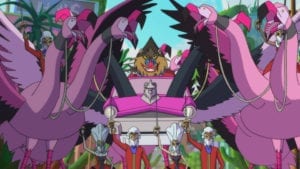
The episode “Sympathy for the Mandrill” highlights the better aspects of Hugo turned Scarlemagne and shows Kipo doing her best to convince Scarlemagne to give up his wish for absolute power. Unsurprisingly it doesn’t work, but what it does do is teach the audience (primarily children) that people should get a second chance and it doesn’t hurt to be kind and compassionate.
Still, Kipo (and the audience) learn that second chances, kindness, compassion, and love are not enough to turn tyrants into good people…animals. By the way, there are a number of characters who still don’t like Kipo or humans even after she’ shows them that people are not all awful. This is an important distinction because just like in real life, some oppressors will never ever care about those who they oppress and no number of chances will magically make them give a damn. Scarlemagne’s refusal to change sets up the second season finale, an absolute master act of an episode between Kipo and her friends all trying to stop Scarlemagne, and the secondary villain.
In the best twist and another example of how much the writers have thought through the implications of what it means that humans were experimenting on animals, we learn that the true villain is like Tumblr states, a “white blonde blue-eyed woman with a Karen haircut.” Emilia, the head researcher on the project hates mutes and wants to return all animals to normal so that humans can live on the surface and rule once again.
Clearly that didn’t work out so well since it’s heavily implied the humans in 2020 and their actions somehow led to the animals mutating in the first place. Emilia’s actions directly lead to Hugo’s turn into Scarlemagne, Song getting stuck as a megamonkey, and the destruction of the first human burrow. Even though the audience can understand both Scarlemagne and Emilia’s motivations, it’s clear that their actions are wrong.
Truly Inclusive Representation
The choice to make the lead scientist a white woman and have white voice actors for both villains is successful precisely because zero of the other main characters are white. Kipo is Black and Korean (voiced by Karen Fukuhara), while Wolf (Sydney Mikayla) and Benson (Coy Stewart) are both Black. Dave too is voiced by a Black man (Deon Cole), Sterling K. Brown is Lio, and Jee Young Hang is Song. While previous cartoons have characters of color, many are portrayed by white voice actors which is really gross! So the dedication by Sechrist, Wolkoff, and the rest of the team to casting appropriately is simultaneously the absolute minimum and yet another plus to the series.
Bringing it back to Benson’s coming out, which is a truly lovely scene. It occurs when he takes Kipo to Ratland, an amusement park to celebrate her 13th birthday. Though it’s awkward for Kipo, the awkwardness lasts about ten seconds before they hug and move on. Then, when we meet Troy, Benson’s crush is presented with adorable music and later Troy even kisses Benson on the cheek! Even more refreshing is Troy’s father, Roberto who loves his son and there’s absolutely zero of the “oh no my son is gay, what will I do” premise. Considering it’s 2200, there’s no reason for that premise anyways!
Similarly, the decision to include multiple biracial characters highlights the dedication to a truly representative cast. Troy’s father Roberto (Antonio Alvarez) has an accent which led to twitter users asking about Troy’s background. Sechrist and writer Taylor Orci (Vida) confirmed that Troy is Asian and Mexican, modeled after Orci’s father and grandfather! Sechrist’s statement that he really wanted an Asian heartthrob is so incredible to me because he’s right. When do Asians get to be the love interest? I’m sure there’s all sorts of other comments and confirmations on Twitter that I’ve yet to find, but I’m really excited to dig deep and see what else the incredible team has to say about their show.
It’s amazing what having an inclusive team does for a show, since we know from the WGA West report that inclusion in the writer’s room is still far from parity. That inclusive writing and casting lends a realism to a story set so far into the future and mostly outlandish plot about mutated animals. Although with the way the world is, mutated animals forcing all humans underground in a couple hundred years is just as likely as any other post-apocalyptic scenario. I jest. Mostly.
Like I said on Twitter during my live-tweeting the entire show in the course of one night, I have seen over 130 cartoons and kids shows. This is absolutely my favorite show and I am waiting on pins and needles for a third season announcement. With a tightly written and laugh out loud plot, incredibly complex characters, beautifully colorful animation, and epic music, this show deserves multiple seasons to explore what happens next.
How will Kipo and her friends stop Emilia from turning the mutes back into “regular” animals? What happens to Scarlemagne now that he’s held by the Timbercats? Will Benson and Troy get together? Is Jamack going to join the group? These are just some of the hundreds of questions that I have, and I can’t wait to get answers to them!


